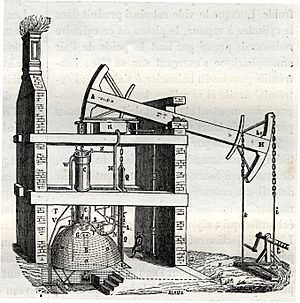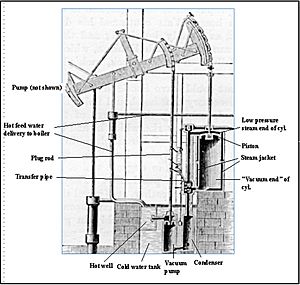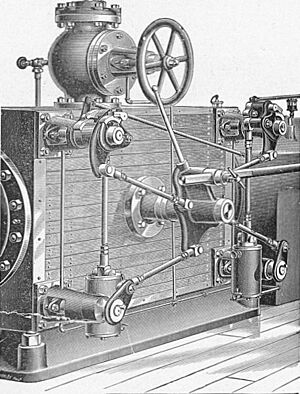History of the steam engine facts for kids
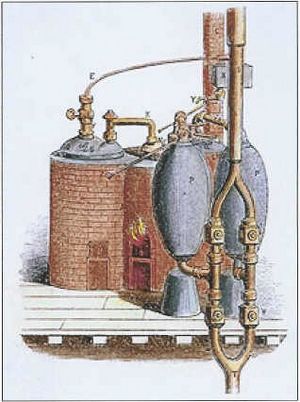
The steam engine is a machine that uses the power of steam to create movement. It was a super important invention that changed the world during the Industrial Revolution. Before steam engines, people relied on water, wind, or animal power. Steam engines helped power factories, trains, and ships, making things faster and easier to produce and transport.
The very first ideas for steam-powered devices go way back to ancient times. Later, in the 17th century, inventors like Thomas Savery and Thomas Newcomen created the first practical steam engines. Newcomen's engine, built in 1712, was the first to use a piston and cylinder, which became the basic design for many years. It was mainly used to pump water out of coal mines.
Over time, steam engines became more efficient and powerful. They were eventually replaced by more modern engines like the steam turbine (which generates most of our electricity today) and the internal combustion engine (like those in cars). But the steam engine's impact on history was huge!
Contents
Early Steam Ideas
Ancient Steam Power
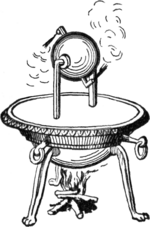
People have been thinking about using steam for a long time! Around 400 BC, a Greek inventor named Archytas made a wooden bird that moved along wires using steam.
The earliest known steam engine was the aeolipile. It was described by Hero of Alexandria in ancient Roman Egypt about 2,000 years ago. Imagine a spinning ball that shot out steam, making it turn! It wasn't very powerful, but it showed that steam could create movement.
Later, in 1125, there was a church in France that had an organ powered by air from heated water. This was another early example of using steam.
Steam Cannons and Pumps
In the late 1400s, the famous inventor Leonardo da Vinci designed a steam-powered cannon called the Architonnerre. This cannon would use hot water in a sealed, hot barrel to create a huge amount of steam pressure, launching heavy cannonballs with great force. Many of the ideas from this design were later used in real steam engines.
In 1606, a Spanish inventor named Jerónimo de Ayanz y Beaumont got a patent for a steam-powered water pump. This pump was actually used to drain flooded mines in Spain!
In 1679, a French scientist named Denis Papin invented the Steam digester, which was like an early pressure cooker. He also experimented with using a piston in a cylinder to create power from steam. He realized that steam needed to be made in a separate boiler for an engine to work continuously.
Building Commercial Steam Engines
The steam engine as we know it came together thanks to several key ideas:
- Understanding how a vacuum works (a space with very low pressure).
- Understanding pressure itself.
- Ways to create a vacuum.
- Ways to make steam.
- The idea of a piston moving inside a cylinder.
Newcomen's "Atmospheric" Engine
Thomas Newcomen was a merchant who sold iron goods. In 1712, he created the first truly practical steam engine that could be used for business. It was called the "atmospheric engine."
Newcomen's engine used a large beam that rocked back and forth. One end of the beam was connected to a pump in a mine, and the other end was connected to a piston inside a cylinder.
Here's how it worked:
- Steam was let into the cylinder, pushing the piston up.
- Then, cold water was sprayed into the cylinder. This made the steam turn back into water (condense), creating a vacuum.
- Because there was a vacuum inside the cylinder and normal air pressure outside, the air pressure pushed the piston down. This "power stroke" pulled the beam down, lifting the water out of the mine.
- The weight of the pump rods then pulled the beam back up, lifting the piston and getting it ready for the next cycle.
Newcomen's engines were big and used a lot of coal, but they were amazing for their time. They could pump water out of mines much better than anything before. By 1735, over 100 Newcomen engines were working in England!
Savery's Steam Pump
Before Newcomen, Thomas Savery designed a "fire-engine" or "Miner's Friend" in 1698. This was a pump that used steam, but it didn't have a piston.
Savery's pump worked by:
- Letting steam into a container to push out the air.
- Then, cold water was poured over the container to make the steam condense, creating a vacuum.
- This vacuum sucked water up into the container.
- Finally, more steam was used to push the water out and up to a higher level.
Savery's engine was useful for pumping water out of mines, but it had some problems. It wasn't very safe because it used high-pressure steam, and the materials at the time weren't strong enough to always hold the pressure. This could lead to explosions.
Watt's Improved Engine
James Watt was an instrument maker at the University of Glasgow. In 1759, he became fascinated with steam engines. He realized that Newcomen's engine wasted a lot of steam because the cylinder cooled down too much with each stroke.
Watt's big idea, in 1765, was to add a separate condenser. This was a different chamber where the steam would go to cool down and turn back into water. This meant the main cylinder could stay hot all the time, making the engine much more efficient.
Watt didn't stop there! He made many other improvements:
- He added a vacuum pump to pull steam into the condenser faster.
- He closed off the top of the cylinder and used low-pressure steam to push the piston down, instead of just relying on air pressure. This made the engine more powerful.
- He developed a way to make the engine "double-acting," meaning steam pushed the piston in both directions, making it work faster and smoother.
- He also invented a special device called a governor to control the engine's speed.
Watt's engines were much more efficient and reliable. His company, Boulton and Watt, became very successful. These improved steam engines were crucial for powering factories and machines during the Industrial Revolution.
High-Pressure Steam Engines
As the 18th century ended, people wanted even more powerful engines. James Watt was worried about this because he thought high-pressure boilers were too dangerous. But other inventors saw the benefits.
High-pressure engines had big advantages:
- They could be made much smaller for the same amount of power. This meant steam engines could finally be used to power vehicles like ships and trains!
- They were cheaper to build.
- They didn't need as much cooling water as Watt's engines.
- They could run faster, which was great for powering machinery.
The main challenge was safety, as boilers could explode if not built well.
In 1769, Nicolas-Joseph Cugnot built a steam-powered wagon, one of the first self-propelled vehicles. It showed the potential for steam in transportation.
In the US, John Fitch built a steamboat in 1788 that carried passengers on the Delaware River. Later, Robert Fulton used a Watt engine to power the first commercially successful steamboat in 1807.
Trevithick and Cornish Engines
In 1800, Richard Trevithick invented the first high-pressure steam engine. He also built the first self-propelled railway steam engine, or steam locomotive, which was demonstrated in Wales in 1804.
Trevithick and others also improved the "Cornish engine," which was used for pumping water. They increased the steam pressure and improved the condensing process. These engines were very efficient and were used for many years, especially in mines.
Corliss and High-Speed Engines
The Corliss steam engine, patented in 1849, was a huge step forward. It had much better speed control and efficiency, making it perfect for all kinds of factories, including those making textiles.
George Corliss used special valves that opened and closed quickly, reducing wasted steam. His engines could also automatically adjust their speed, which was very important for factory machines.
Later, in 1862, the Porter-Allen high-speed engine was introduced. These engines ran much faster and were very precise. They were used in sawmills and for generating electricity.
Uniflow Engine
The uniflow engine, invented in 1911, was one of the most efficient types of high-pressure engines. It was used in ships, steam locomotives, and steam wagons. However, it was eventually replaced by steam turbines and diesel engines, which were even more powerful and efficient for those uses.
See also
 In Spanish: Historia de la máquina de vapor para niños
In Spanish: Historia de la máquina de vapor para niños


